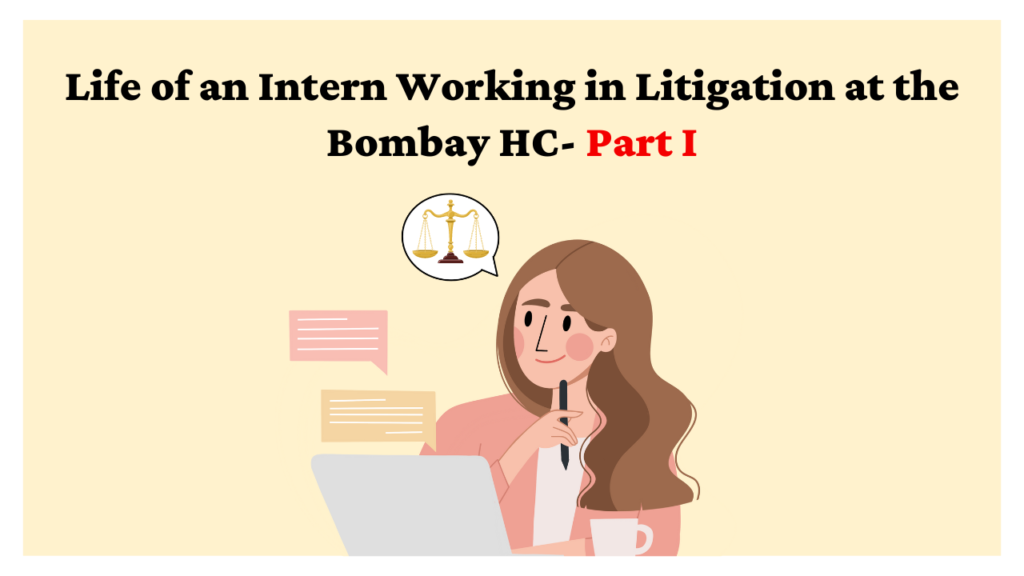
Introduction
While I entered the Bombay High Court for the first time, I was astounded by the magnificence of the structure and its history. While people walked at an immense pace to get to their matters, I was in the sea of imagining myself as one of these lawyers someday when I met my boss for the first time. While she had been a counsel for over 20 years, here I was starting afresh as I had done virtual internships in litigation during the pandemic and had mostly interned with Tier-1 law firms. While the internship was a memorable one, I realized a number of things which first timers do not understand when they enter the Bombay High Court. The blog serves as a roadmap to the requirements and expectations from an intern working in any litigator or dispute resolution vertical. While many lawyers morally write about their expectations from interns, this blog uniquely describes practical lessons learnt over an internship and know how’s for a new entrant in law school.
Original and Appellate Side
The Bombay High Court hears millions of grievances on a daily basis but is divided into the original and appellate side. As the name suggests, original side refers to cases whereby the court hears the case for the first time or has original jurisdiction in the matter which the High Courts and Supreme Court do by way of Article 226 and 32 of the Constitution. The appellate side hears cases which are brought in appeal from lower courts by aggrieved parties. The administration of these sides is well demarcated which is shown by practical examples below.
Parties
Normally students face a problem in understanding which party they represent when they are handed a file. To put it simply, plaintiff or petitioner are parties which have instituted the case against the respondent and defendant, Suppose, in the court, person X is the petitioner and person Y is the respondent and the decision goes against Y, when he/she appeal to a higher forum he/she would become the appellant while the petitioner will become the respondent.
Mentioning and Preciepe
You would see many lawyers running between 10:28 AM- 10:30 AM in the corridors of the Bombay High Court for mentioning. “Mentioning” refers to a practice whereby any lawyer who wants his/her case to be taken up on priority or wants to produce any fact to the court which is of utmost importance and action needs to be taken on the same would mention it through a document called the preciepe. Preciepe is a one/ two-page document which highlights the relief sought and normally mentions the urgency for listing the matter before the bench. It starts with the name of the case right at the top and is addressed to the prothonotary on the original side and the registrar on the appellate side. This is followed by the body of the preciepe which indicates the reasons, meaning and already pass order (if any) in the matter. The last line indicates that the papers and proceedings of the following case must be placed before the concerned judge for hearing and disposal.
Cause List
This list is the holy grail for lawyers as it shows as to when a matter belonging to the lawyer is listed before the concerned judge. There are two types of cause lists i.e., weekly and daily cause lists. Weekly cause lists come usually around Friday and represent the number of cases listed before the judge, but the daily cause list comes around 6.00-8.00 AM depending on the judge on the preceding day which includes the matters listed before the judge which may have been mentioned while granting the preciepe or otherwise. The other type of cause list is the supplementary cause list which forms part of the daily cause list and consists of matters which may have been mentioned for urgent hearing by the lawyer or firm concerned. These matters are heard normally out of turn.
Display board
When one runs between courtrooms and wants to check the case number going on in a particular court room, there are often numbers ranging from 1-100 or 501 onwards or 901 onwards. The numbers are symbolic and refer to the different kinds of boards being taken up by the judges in their respective courtrooms. These may range from supplementary matters to production matters to regular hearings etc. for more information one may refer to the blog written by Dr. Abhinav Chandrachud on “litigation 101: Bombay High Court practice and procedure”
Assignment
While many interns are told to go to a courtroom with a file, a question may arise as to why the said courtroom must only be gone to as there are many other court rooms which may relatively free or have lesser number of cases to be heard. This is due to the process of assignment whereby the Chief Justice of the any High Court once in a while publishes a list whereby a particular court is given the charge/responsibility to hear matters pertaining to a particular field of law. For example, land matters will be heard in courtroom X while criminal appeals may be heard in courtroom Y. While filing or mentioning cases before a court the intern must understand the assignment of the particular court room failing which he may confuse his senior.
Stamp and Register number
When an intern is given a case file, the first line indicates the case name, and a number is assigned to the same. Now sometimes these numbers are preceded by the letter (L). While only numbers refer to a registered case, a case with numbers and (L) refers to a case which is not registered but has got a stamp number. These cases with stamp number are under office objections which means till office objections are removed some judges don’t even entertain these cases. Hence if you are an intern, you endeavour must be to try and find out as to what the objection is and how can the same be corrected.
The file in one’s hand
While interns are normally handed files by a litigator to keep in their custody, when interns try to read the same, they face a mini paralysis considering the amount of documentation contained in the files. The optimum way to read it as taught by my senior would be to see the prayers of the party instituting the case. This shows as to whether one is a necessary or proper party. While the Civil Procedure Code (CPC) defines both these terms, to put it simply necessary party as the same suggests refers to a party without whom the case cannot be decided while a proper party is one who may not have an active role in the case, but its presence holds significance to the outcome of the case or the case’s outcome may have an effect of the said party.
Post this preliminary reading if one is given the opportunity to peruse through the files, he/she must read it in the present order to understand the contents in a more comprehensive manner:
- Plaint– The plaint forms the primary document of the file which points out the cause of action and the case of the plaintiff against the respondent. This reflects the problem and what the plaintiff intends to achieve if the same is ruled in his/her favour. The expectations of the plaint are set out in the prayer whereby the party requests the court to grant the reliefs as indicated in the prayer to the plaintiff.
- Written Statement– This is the counter to the plaint filed by the respondent which contains averments made to vitiate or outweigh the case as led by the plaintiff.
- The law also permits filing of amended plaint and additional written statement and hence a case file may also contain this whereby parties add grounds or new information which may have come to light post institution of the plaint or written statement.
- Replication– This is the plaintiff’s reply to the case put forth by the respondent in their written statement
- Rejoinder– A respondent will reply to the averments or statements made in the replication by filing a rejoinder
- Sur rejoinder– The plaintiff as a final move, may serve the sur rejoinder which is an answer to the averments put forth in the rejoinder.
As a practice, the points made in each of these documents are not repeated by the same party and hence drafting these documents is a work of art. While the High Court is known for many kinds of documentation it is mainly prevalent for hearing and ruling on writs which are filed by individuals against the government. The second part of the series covers the same and covers ingredients of documentation as filed in the High Court.
YLCC would like to thank Nikhilesh Koundinya (5th year, Symbiosis Law School, Pune) for writing this insightful piece.
Find Part-II of this article HERE.








